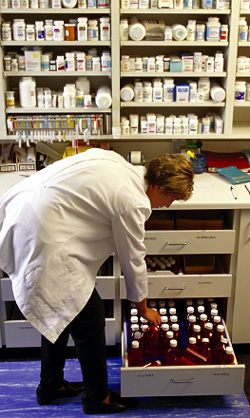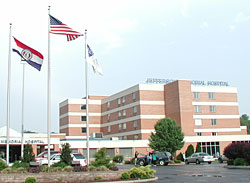Evidence-Based Medicine in the Pharmacy
March / April 2006
Evidence-Based Medicine in the Pharmacy
![]()
 U.S. aphorist Mason Cooley said, “Theory can leave questions unanswered, but practice has to come up with something.” Nowhere does this apply better than the increasingly prevalent practice of evidence-based medicine (EBM). For while everyone believes EBM makes sense theoretically, only a few organizations have actually found a practical way to implement it. Jefferson Memorial Hospital in Crystal City, Missouri, is one of those few.
U.S. aphorist Mason Cooley said, “Theory can leave questions unanswered, but practice has to come up with something.” Nowhere does this apply better than the increasingly prevalent practice of evidence-based medicine (EBM). For while everyone believes EBM makes sense theoretically, only a few organizations have actually found a practical way to implement it. Jefferson Memorial Hospital in Crystal City, Missouri, is one of those few.
For more than 40 years, Jefferson Memorial Hospital has stayed true to its original goal to provide quality healthcare conveniently to the people of Jefferson County and surrounding communities. Licensed for 226 beds, the hospital’s five-story structure and surrounding campus feature a home care/hospice center, two medical office centers, an oncology center, the Deles Heart and Cardiovascular Center, and the Crystal Oaks Complex, which includes residential care and skilled nursing facilities. Recent expansion has included an outpatient imaging center, wound care center, and women’s health center. A geriatric psych facility will open in the spring of 2006. Located 30-plus miles from St. Louis, in the Twin Cities area, the hospital employs nearly 1,500 people, including more than 170 physicians and specialists — and it continues to grow.
EBM: What It Is, What It Takes
In recent years, EBM has become the holy grail of healthcare delivery, valued for its ability to reduce medical error and healthcare costs. The most common definition of EBM is taken from Dr. David Sackett: “… the conscientious, explicit and judicious use of current best evidence in making decisions about the care of the individual patient. It means integrating individual clinical expertise with the best available external clinical evidence from systematic research (1996).”
|
For pharmacists, “evidence” is drug data — what the drugs are, how they are used, how they interact with other drugs, and the latest best practice treatment recommendations for common and uncommon conditions. And pharmacists believe this data is critical to their practice. In a recent survey of pharmacists, 90% held positive attitudes toward EBM and 84% thought research findings were important to daily practice (Burkiewicz & Zgarrick, 2005). Unfortunately, positive opinions are not enough.
Not surprisingly, lack of time is the biggest obstacle to EBM use (Burkiewicz & Zgarrick, 2005). To practice it, pharmacists must stay abreast of the most up-to-date information on drug therapy, comprising more than 600 new articles each week (Felkey & Fox, 2003). Other obstacles include physician attitudes toward pharmacist recommendations and access to resources (Burkiewicz & Zgarrick, 2005).
For pharmacists, quality drug knowledge resources, optimally integrated into clinical workflow, enable EBM. These resources constitute two types of information (Micromedex, in press):
- Reference information. Drug reference information should answer specific questions about a wide range of drugs, including FDA-approved and investigational prescription, and non-prescription drugs, non-U.S. preparations and complementary and alternative medications. The information should be easy to understand and consistent for the full spectrum of users — from clinicians to patients.

- Proactive information. Targeted patient-specific alerts can notify clinicians of potential medication use problems of which they might not otherwise be aware. Optimally, the guidance should be delivered via the most appropriate channel at the most appropriate point in the clinician’s workflow (e.g., via computerized work-flow tools for pharmacists, computerized physician order entry [CPOE] for physicians, and medication administration systems for nurses).
To facilitate EBM, drug databases must be accurate and reliable; comprehensive; timely, updated frequently; and consistent for all stakeholders throughout the medication use cycle. Using these criteria, Jefferson Memorial selected a database solution in 2002.
Drug Data on Demand
Jefferson Memorial Hospital’s new computerized drug database gives pharmacists evidence-based documents covering FDA-approved and investigational prescription and nonprescription drugs, as well as non-U.S. preparations. The database provided information on dosage, pharmacokinetics, cautions, interactions, clinical applications, adverse effects, comparative efficacy, drug of choice information, and orphan drug status. The hospital also installed a system to provide easy-to-understand drug education to patients.
Jefferson Memorial was not using an integrated information system, but the drug database was available on the same desktop for quick reference. The database was integrated into the hospital’s Intranet so nurses, pharmacists, and physicians could look up information on any desktop in the hospital with Internet access.
Typically, a pharmacist identifies a need for intervention (e.g. non-formulary drug request, dose calculation, etc.) and searches the appropriate databases for evidence-based documentation the prescriber should consider. The databases are also available to pharmacists on their handheld devices for easy access when they are not at a network workstation.
Currently, pharmacists communicate with physicians via a communications form in the chart or a telephone call. The hospital is implementing an integrated information solution with a CPOE function that will allow pharmacists to communicate electronically with physicians.
In conjunction with the University of Colorado Health Sciences Center School of Pharmacy, Jefferson Memorial surveyed its pharmacists about their use of the database. They reported using it most often for:
- Pediatric dosing, drug interactions, and routes of administration

- Patient-specific dosing calculators

- Toxicology nomograms

- Drug identification

- Drug information inquiries, including referenced studies if needed for more detail

- Therapeutic interchange and drug comparison

- Off-label use information

- Acute care information

- Disease state management
Table 1 summarizes the survey’s findings.
| Pharmacy | Nursing | |
| PRIMARY DATABASE USE |
|
|
| PRIMARY OPINIONS |
|
|
| Source: University of Colorado Health Sciences Center and Micromedex | ||
![]()
In 2003, the hospital implemented a drug identification database. Designed to help pharmacists quickly identify unknown tablets and capsules by imprint code or slang term, the tool provides physical characteristic descriptions, as well as drug images, ingredients, and manufacturer data.
Pharmacy was the initial user of the databases. Later, in 2003, the hospital made them accessible to nursing. Today, they are available to patient care personnel on any PC on the hospital network. Nurses’ primary uses for the data include:
- Patient discharge instructions

- Medication administration

- Drug information (as opposed to calling pharmacy for answer)

- Teaching drug therapy to nursing students and nurses
To ensure requisite access, the databases were made accessible via the Internet, Jefferson’s Intranet, and on handheld PDAs.
Better Care Through Data
Implementing the drug databases has had both tangible and intangible results. Tangible results measured over the first quarter of 2004 (January 1 to April 2004) revealed:
- Improved patient outcomes: Improvements in drug therapy because of updated, best practice data at key decision/treatment points were the improved patient outcomes in more than 70% of cases.

- Cost savings: Pharmacist-initiated interventions in which drug databases were utilized for information about drug-drug interactions resulted in an estimated annual cost savings of $14,296. Dosage adjustments produced estimated annual savings of $5,316. See Table 2.
| Primary use | Quarterly Savings | Projected Annual Savings | Per Pharmacist Savings |
| Drug-drug Interactions | $3,574 | $14,296 | $2,383 |
| Dosage Adjustment | $1,329 | $5,316 | $1,833 |
| Disease/Indication Information | $102 | $408 | $68 |
| Patient Education | $127 | $508 | $85 |
| Other | $836 | $3,344 | $557 |
| Total Savings | $5,968 | $23,872 | $3,979 |
| Source: University of Colorado Health Sciences Center and Micromedex | |||
![]()
The most important intangible result is the improvement of interdisciplinary communications and relationships. Having the data integrated with workflow and richly deployed allows pharmacists to provide immediate answers to physicians despite either one’s physical location. This has engendered a discernible improvement in pharmacists’ credibility with physicians.
On the other hand, providing the data to nurses has eliminated pharmacy as their primary source of drug data. Having direct access to answers eliminates nursing’s need to call the pharmacy, streamlining workflow and improving the immediacy of patient care. Moreover, it empowers and educates nurses for overall improved clinician and patient satisfaction.
EBM: From Theory to Practice
Like all U.S. hospitals, Jefferson Memorial’s increasing focus on medication safety is a primary EBM driver. A mandate from the Joint Commission for Accreditation of Healthcare Organizations (JCAHO) for a formal medication reconciliation process underscores the need for top-quality drug data. Medication reconciliation ensures that all members of the care team share an accurate understanding of what medications the patient is taking, particularly at care transition points. The formal, three-step process comprises:
- Obtaining a complete and accurate list of each patient’s current home medications — including name, dosage, frequency, and route.

- Comparing the physician’s admission, transfer, and/or discharge orders to that list.

- Bringing discrepancies to the prescriber’s attention to make and document warranted changes to the orders (IHI).
Other initiatives fueling the use of informational databases to improve the safety and quality of medications include The Institute for Healthcare Improvement’s 100,000 Lives Campaign (100K Lives), which asks U.S. hospitals to commit to changes that would improve patient care and prevent avoidable deaths; and JCAHO’s National Patient Safety Goals, which are pushing hospitals to use the reconciled medication lists whenever patients move to a new setting, service, or level of care (Micromedex, in press). Access to drug data where and when it is needed, will help Jefferson Memorial meet these requirements.
One area where the hospital hopes further to realize value is using the databases to reconcile and research foreign trade names for drugs. In an increasingly global economy, this ability becomes ever more crucial.
In the future, Jefferson Memorial would like to use its databases to create cost indexes that rank drugs from most to lease expensive by class, giving the hospital the ability to determine best in class by price. Such determinations could produce significant cost savings.
The hospital is also implementing an electronic system to integrate microbiology data with the pharmacy module of the hospital information system to create an infectious disease database. This system will cite and display evidence-based studies and articles that support practice recommendations. A multidisciplinary antibiotic stewardship team will use the data to make timely recommendations for the most efficacious antimicrobial therapy.
EBM is still a theory to a great degree because the base of evidence is overwhelming, and the clinicians who need it are overwhelmed. However, Jefferson Memorial Hospital has found a way to move EBM from theory to reality, improving care by putting the right data in the hands of the right clinicians right when they need it.
Jim Davidson is director of pharmacy services at Jefferson Memorial Hospital in Crystal City, Missouri.
Kavita Nairis assistant professor and Robert Valuck is associate professor in the department of clinical pharmacy at the University of Colorado Health Sciences Center School of Pharmacy in Denver.
Gina Moore is director of product management at Thomson Micromedex in Greenwood Village, Colorado. She may be contacted at gina.moore@thomson.com.
References
Burkiewicz, J. S., & Zgarrick,D. P. (2005). Evidence-based practice by pharmacists: Utilization and barriers. Annals of Pharmacotherapy 39(7- 8), 1214-1219. Epub 2005, Jun 14.
Felkey, B., & Fox, B.I. Emerging technology at the point of care. Journal of the American Pharmacy Association 43(5 Suppl 1), S50-1.
Institute for Healthcare Improvement (IHI).Web&ACTION: Preventing adverse drug events through medication reconciliation. http://ihi.org/IHI/Programs/ConferencesAndTraining/WebActionADE.htm.
Micromedex. Harnessing the power of clinical decision support to promote safer and more cost-effective medication use.White paper. http://www.micromedex.com. In press.
Sackett,D. L., Rosenberg,W. M., Gray, J.A., Haynes, R. B., & Richardson,W. S. (1996). Evidence based medicine:What it is and what it isn’t. British Medical Journal, 312(7023), 71-2.

